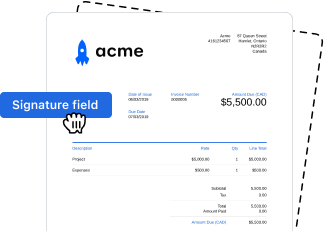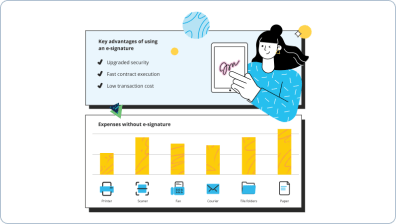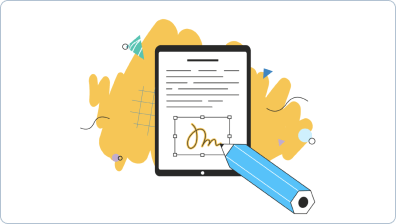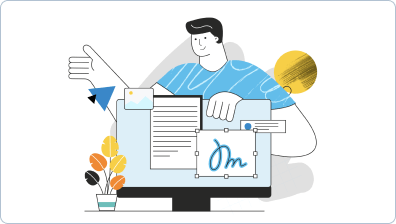Sign Physical Exam Consent
- Quick to start
- Easy-to-use
- 24/7 support
Simplified document journeys for small teams and individuals




We spread the word about digital transformation
Why choose airSlate SignNow
-
Free 7-day trial. Choose the plan you need and try it risk-free.
-
Honest pricing for full-featured plans. airSlate SignNow offers subscription plans with no overages or hidden fees at renewal.
-
Enterprise-grade security. airSlate SignNow helps you comply with global security standards.







Excellent form management with airSlate SignNow
Gain access to a rich form catalog
Make reusable templates
Collect signatures through secure links
Keep documents safe
Enhance collaboration
eSign through API integrations
Quick-start guide on how to build, fill in, and sign physical consent sign
Think of all the paper that you waste to print physical consent template, not counting the countless other documents that are dozens of pages long that your organization uses weekly. That's a lot of wasted paper. It directly correlates to wasted natural resources and, of course, as well as spending budget. With airSlate SignNow eSignature, you can go digital, decreasing waste and improving efficiency.
Follow the steps listed below to modify and sign physical exam fillable quickly:
- Launch your web browser and access signnow.com.
- Sign up for a free trial run or log in with your electronic mail or Google/Facebook credentials.
- Select User Avatar -> My Account at the top-right area of the webpage.
- Modify your User Profile by adding personal data and altering configurations.
- Make and manage your Default Signature(s).
- Get back to the dashboard webpage.
- Hover over the Upload and Create button and choose the appropriate option.
- Click on the Prepare and Send key next to the document's title.
- Type the email address and name of all signers in the pop-up screen that opens.
- Make use of the Start adding fields option to proceed to modify file and self sign them.
- Click on SAVE AND INVITE when accomplished.
- Continue to fine-tune your eSignature workflow employing extra features.
It can't get any easier to sign a sign consent electronically than that. If creating, editing, signing and tracking numerous templates and forms sounds like an administrative hassle for your teams, give powerful eSignature by airSlate SignNow a try.
How it works
Rate physical exam fillable
What is the physical consent sign
The physical consent sign is a document that allows individuals to provide their consent for a specific action or procedure, typically related to medical examinations or treatments. This document serves as a formal agreement, ensuring that the individual understands the nature of the procedure and any associated risks. In a digital context, the physical consent sign can be completed and signed electronically, streamlining the process and enhancing accessibility.
How to use the physical consent sign
Using the physical consent sign electronically involves a few straightforward steps. First, the document can be accessed through a digital platform like airSlate SignNow. Users can fill out the necessary fields, which may include personal information, details about the procedure, and acknowledgment of risks. Once completed, the document can be sent for signature to the relevant parties, ensuring that all necessary consents are collected efficiently.
Steps to complete the physical consent sign
To complete the physical consent sign electronically, follow these steps:
- Access the physical consent template on airSlate SignNow.
- Fill in the required fields with accurate information.
- Review the document to ensure all details are correct.
- Send the document for signature to the designated individuals.
- Receive notifications when the document is signed by all parties.
- Store the completed document securely within your airSlate SignNow account.
Legal use of the physical consent sign
The physical consent sign holds legal significance in the United States, as it demonstrates that informed consent has been obtained. Electronic signatures are recognized under the Electronic Signatures in Global and National Commerce (ESIGN) Act, ensuring that eSigned documents are legally binding. It is important to ensure that the document complies with state-specific regulations regarding consent forms to maintain its legal validity.
Key elements of the physical consent sign
Several key elements should be included in a physical consent sign to ensure clarity and legality:
- Patient Information: Full name, date of birth, and contact details.
- Procedure Details: A clear description of the procedure or treatment being consented to.
- Risks and Benefits: An outline of potential risks and benefits associated with the procedure.
- Signature Section: A designated area for the individual to provide their eSignature.
- Date: The date on which consent is given.
Security & Compliance Guidelines
When handling the physical consent sign electronically, it is essential to adhere to security and compliance guidelines to protect sensitive information. airSlate SignNow employs encryption and secure storage to safeguard documents. Additionally, ensure that all signers are verified and that the eSignature process complies with relevant regulations, such as HIPAA for health-related documents, to maintain confidentiality and integrity.
-
Best ROI. Our customers achieve an average 7x ROI within the first six months.
-
Scales with your use cases. From SMBs to mid-market, airSlate SignNow delivers results for businesses of all sizes.
-
Intuitive UI and API. Sign and send documents from your apps in minutes.
FAQs sign consent electronically
-
What is a physical consent sign and how does it work?
A physical consent sign is a digital solution that allows users to obtain consent through electronic signatures. With airSlate SignNow, you can easily create, send, and manage documents that require physical consent, ensuring a streamlined process for both you and your clients.
-
How much does airSlate SignNow cost for physical consent sign features?
airSlate SignNow offers competitive pricing plans that cater to various business needs. The cost for utilizing physical consent sign features is included in our subscription plans, which provide access to a range of eSigning tools and functionalities.
-
What are the key benefits of using airSlate SignNow for physical consent sign?
Using airSlate SignNow for physical consent sign enhances efficiency and compliance. It allows businesses to quickly gather consent, reduces paperwork, and provides a secure way to store signed documents, all while maintaining a user-friendly experience.
-
Can I integrate airSlate SignNow with other applications for physical consent sign?
Yes, airSlate SignNow offers seamless integrations with various applications, enhancing your workflow for physical consent sign. You can connect it with CRM systems, cloud storage services, and other tools to streamline your document management process.
-
Is airSlate SignNow secure for handling physical consent sign documents?
Absolutely! airSlate SignNow prioritizes security and compliance, ensuring that all physical consent sign documents are protected with advanced encryption and authentication measures. This guarantees that your sensitive information remains confidential and secure.
-
How can I track the status of my physical consent sign documents?
With airSlate SignNow, you can easily track the status of your physical consent sign documents in real-time. The platform provides notifications and updates, allowing you to know when a document has been viewed, signed, or completed.
-
What types of documents can I use for physical consent sign?
You can use a variety of document types for physical consent sign with airSlate SignNow, including contracts, agreements, and consent forms. The platform supports multiple file formats, making it versatile for different business needs.
Physical consent sign
Trusted eSignature solution - sign consent online
Related searches to physical exam consent
Join over 28 million airSlate SignNow users
Get more for physical exam consent
- Electronic Signature Legality for Animal Science in ...
- Electronic Signature Legality for Animal Science in ...
- Understanding electronic signature legality for Animal ...
- Electronic Signature Legality for Animal Science in ...
- Electronic Signature Legality for Animal Science in ...
- Electronic Signature Legality for Banking in Mexico: ...
- Electronic Signature Legality for Banking in Australia: ...
- Electronic signature legality for Banking in United ...
The ins and outs of eSignature




















































